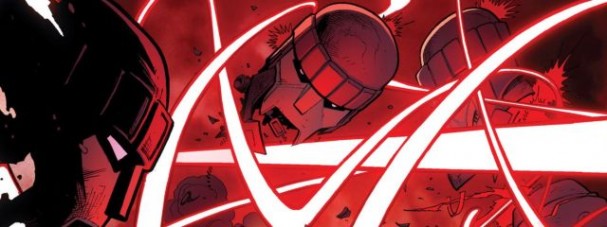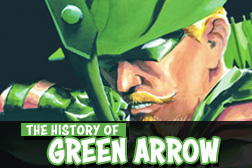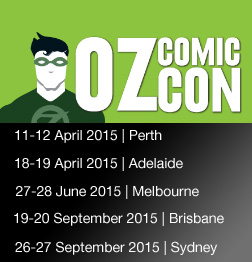Don’t have time for full reviews of comics? Then check out Graphic Bits: bite sized chunks of comic book goodness designed to get behind the panels and into your hearts.
This week (4 September 2013), Marvel comes at us with not one but two events in X-Men: Battle of the Atom #1 and Infinity #2, things get robotic in Avengers A.I. #3, while Jeff Lemire is back stops to smell the flowers in Trillium #2 (DC/Vertigo). This is Behind the Panels.
For the DC releases reviewed this week, check out that column we published earlier that includes reviews for Forever Evil #1, Justice League #23.1, Green Lantern #23.1, Green Arrow #23.1, Batman #23.1, Justice League Dark #23.1 and Justice League of America #7.1. Plus, our featured pick on the this week is The Star Wars: Lucas Draft #1 (Dark Horse).
X-Men: Battle of the Atom #1 – Marvel, Brian Michael Bendis (writer), Frank Cho, Stuart Immonen (artists). Rating: 8.5/10
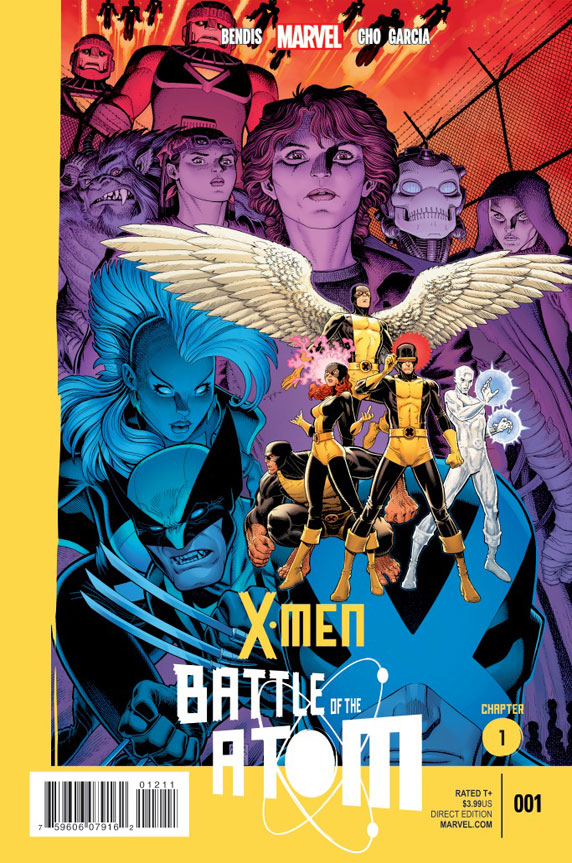 Having learned nothing from Age of Ultron, Brian Michael Bendis pitches not one but three different eras of X-Men against each other in this new event debut. With the original X-Men not wanting to return to their original time, shenanigans ensue when Sentinels attack mutants on the streets and the near-death of young Cyclops temporarily erases modern Scott from the picture. To make matters worse, an X-team from the future travel back to stop something bad from happening. It’s a convoluted but rewarding first issue, but to Bendis’s credit it is also packed to the gills with action and carefully sets up everything you need to know within the boundaries of the issue itself. The art is often quite beautiful, combining Frank Cho and Stuart Immonen’s pencils for a high degree of impact. Yes, it’s all about time travel again, but if there is one thing Brian Michael Bendis is good at it’s openings, but let’s now wait for this to go into an alternative timeline that has nothing to do with the X-Men. Fortunately, we can see the pay off immediately this week by following the saga straight over to All-New X-Men #16…
Having learned nothing from Age of Ultron, Brian Michael Bendis pitches not one but three different eras of X-Men against each other in this new event debut. With the original X-Men not wanting to return to their original time, shenanigans ensue when Sentinels attack mutants on the streets and the near-death of young Cyclops temporarily erases modern Scott from the picture. To make matters worse, an X-team from the future travel back to stop something bad from happening. It’s a convoluted but rewarding first issue, but to Bendis’s credit it is also packed to the gills with action and carefully sets up everything you need to know within the boundaries of the issue itself. The art is often quite beautiful, combining Frank Cho and Stuart Immonen’s pencils for a high degree of impact. Yes, it’s all about time travel again, but if there is one thing Brian Michael Bendis is good at it’s openings, but let’s now wait for this to go into an alternative timeline that has nothing to do with the X-Men. Fortunately, we can see the pay off immediately this week by following the saga straight over to All-New X-Men #16…
All-New X-Men #16 – Marvel, Brian Michael Bendis (writer), Stuart Immonen (artists). Rating: 7.5/10
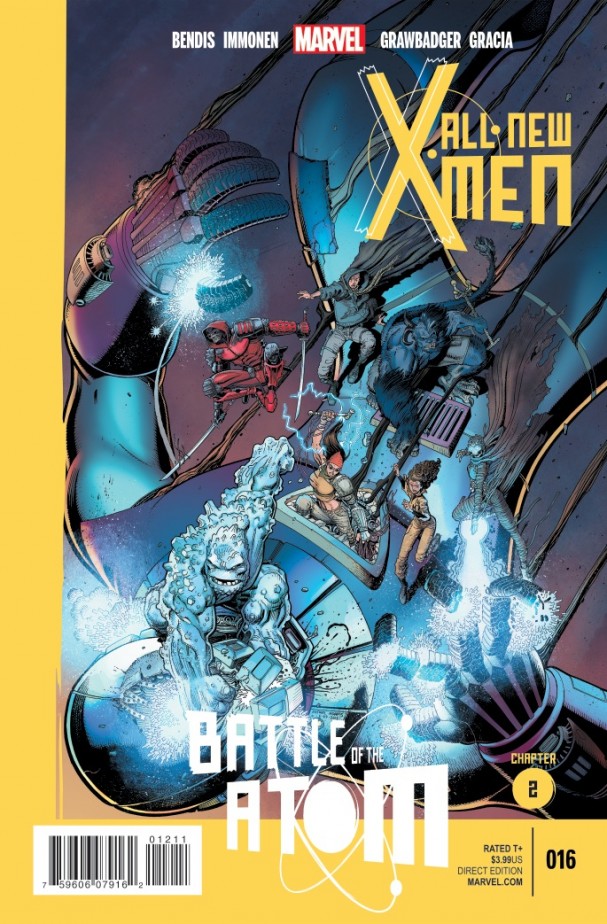 …where the story picks up immediately where X-Men: Battle of the Atom #1 leaves off. Even if you haven’t been keeping up with this title, and with so many X-Men books it isn’t surprising, the only foreknowledge you really need is the previous event issue. This is far more typical of being a second issue than part of the ongoing All-New X-Men, as much of the issue is concerned with the identity of the future X-Men and some familiar squabbling amongst the core members. While the issue itself does very little to push the story along until the final few pages of reveals, there’s a solid bit of character development here, allowing new readers a chance to work out the dynamics of the different teams. Immonen once again conjures up some cinematic art, while Marte Garcia makes liberal use of the colour purple to frame more than one team. More curiosity comes from realising that we are two issues in and we have no idea what the title of this event means. The action continues next in X-Men #5.
…where the story picks up immediately where X-Men: Battle of the Atom #1 leaves off. Even if you haven’t been keeping up with this title, and with so many X-Men books it isn’t surprising, the only foreknowledge you really need is the previous event issue. This is far more typical of being a second issue than part of the ongoing All-New X-Men, as much of the issue is concerned with the identity of the future X-Men and some familiar squabbling amongst the core members. While the issue itself does very little to push the story along until the final few pages of reveals, there’s a solid bit of character development here, allowing new readers a chance to work out the dynamics of the different teams. Immonen once again conjures up some cinematic art, while Marte Garcia makes liberal use of the colour purple to frame more than one team. More curiosity comes from realising that we are two issues in and we have no idea what the title of this event means. The action continues next in X-Men #5.
Avengers A.I. #2 – Marvel, Sam Humphries (writer), Andre Araujo, Frank D’Armata (artists). Rating: 8.5/10
 Now in its third issue, one of the quirkiest consequences of Age of Ultron remains one of the most pleasurable to read, and shows no signs of wearing its concept thin. Indeed, the idea that Pym’s final solution for Ultron gave birth to millions of new artificial lives is a fascinating conundrum, and typically Pym-ironic. Giving the Vision a central seat in the Marvel Universe is definitely a welcome development, this is pure joy and reads like a good Saturday morning cartoon. Humphries manages to pull together some of the biggest and smallest misfits in the 616, and by uniting them makes them more than the sum of their mechanical parts. Former Runaway Victor Mancha (and star of the underrated Ultron #1AU), also gets a book to call his own, and this is one of the many reasons that Arajuo’s crisp and vivid art style pops off the page, with a slick look for the Information Age. Plus, Doombot’s head remains the best comedic gem of 2013, dagnabbit! If anything could make Age of Ultron worthwhile, it’s this book.
Now in its third issue, one of the quirkiest consequences of Age of Ultron remains one of the most pleasurable to read, and shows no signs of wearing its concept thin. Indeed, the idea that Pym’s final solution for Ultron gave birth to millions of new artificial lives is a fascinating conundrum, and typically Pym-ironic. Giving the Vision a central seat in the Marvel Universe is definitely a welcome development, this is pure joy and reads like a good Saturday morning cartoon. Humphries manages to pull together some of the biggest and smallest misfits in the 616, and by uniting them makes them more than the sum of their mechanical parts. Former Runaway Victor Mancha (and star of the underrated Ultron #1AU), also gets a book to call his own, and this is one of the many reasons that Arajuo’s crisp and vivid art style pops off the page, with a slick look for the Information Age. Plus, Doombot’s head remains the best comedic gem of 2013, dagnabbit! If anything could make Age of Ultron worthwhile, it’s this book.
Infinity #2 – Marvel, Jonathan Hickman (writer), Jerome Opeña, Dustin Weaver (artists). Rating: 8/10
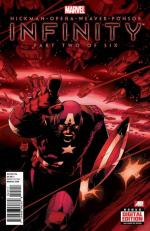 5It may have taken us dozens of Avengers and New Avengers issues and countless chapter headings to get here, but Hickman’s vision is now fully formed, birthing an epic space opera every bit the equal of Annihilation or War of Kings. In this second issue of the main mini-series, he doesn’t simply retell what has been happening in the tie-in issues (save for a one-page recap), but uses them as launching pads for one devastating wave after the next. There’s some very nice moments in this issue, with an all-out space battle that will spin your head and a wonderful moment when Corvus Glaive challenges Black Bolt and Medusa in the very heart of Attilan, showing himself to be a legitimate threat. To keep up with Hickman’s impressively ambitious vision, Jim Cheung is given a break while Jerome Opeña tackles the spacey bits of the outing and Dustin Weaver does some magnificent stuff on planet Earth. As the full extent of Thanos’s plans are revealed, a massive sense of foreboding hangs over the universe. Opena’s illustration is every bit the cinema lovers dream, marrying high concept space battles and decloaking armadas with some grim character moments, such a confrontation in the Inhuman court.
5It may have taken us dozens of Avengers and New Avengers issues and countless chapter headings to get here, but Hickman’s vision is now fully formed, birthing an epic space opera every bit the equal of Annihilation or War of Kings. In this second issue of the main mini-series, he doesn’t simply retell what has been happening in the tie-in issues (save for a one-page recap), but uses them as launching pads for one devastating wave after the next. There’s some very nice moments in this issue, with an all-out space battle that will spin your head and a wonderful moment when Corvus Glaive challenges Black Bolt and Medusa in the very heart of Attilan, showing himself to be a legitimate threat. To keep up with Hickman’s impressively ambitious vision, Jim Cheung is given a break while Jerome Opeña tackles the spacey bits of the outing and Dustin Weaver does some magnificent stuff on planet Earth. As the full extent of Thanos’s plans are revealed, a massive sense of foreboding hangs over the universe. Opena’s illustration is every bit the cinema lovers dream, marrying high concept space battles and decloaking armadas with some grim character moments, such a confrontation in the Inhuman court.
Trillium #2 – DC/Vertigo, Jeff Lemire (writer), Jeff Lemire, José Villarrubia (artists). Rating: 9/10
 The first issue of Trillium began Jeff Lemire’s “grand examination of humanity”, but it’s really just a love story at its heart. After the innovative flip-book for the first issue, allow the reader to come to the same conclusion via two mirrored stories featuring leads separated by 2000 years, the second issue may look far more traditional by comparison. Yet Lemire still mines his bag of tricks, putting us in the place of Nika and William by giving us the same incomprehensible dialogue that the star-crossed duo are trying to work through. It puts the emphasis on the visual aspects of the storytelling, and in this regard the book exceeds in every aspect. As with the first issue, José Villarrubia digitally colours the 1921 pages, which make up the majority of the issue. Indeed, there is only a single page from Lemire’s watercoloured future, but this uses the same colour palette as the historic moments. The slight difference gives us a visual cue of the jarring yet familiar sensation the characters must feel when they cross time zones. While not as immediately arresting as the debut issue, Lemire has crafted a world that has us completely hooked at this point. We can’t wait until the third issue to see what magic he will weave then.
The first issue of Trillium began Jeff Lemire’s “grand examination of humanity”, but it’s really just a love story at its heart. After the innovative flip-book for the first issue, allow the reader to come to the same conclusion via two mirrored stories featuring leads separated by 2000 years, the second issue may look far more traditional by comparison. Yet Lemire still mines his bag of tricks, putting us in the place of Nika and William by giving us the same incomprehensible dialogue that the star-crossed duo are trying to work through. It puts the emphasis on the visual aspects of the storytelling, and in this regard the book exceeds in every aspect. As with the first issue, José Villarrubia digitally colours the 1921 pages, which make up the majority of the issue. Indeed, there is only a single page from Lemire’s watercoloured future, but this uses the same colour palette as the historic moments. The slight difference gives us a visual cue of the jarring yet familiar sensation the characters must feel when they cross time zones. While not as immediately arresting as the debut issue, Lemire has crafted a world that has us completely hooked at this point. We can’t wait until the third issue to see what magic he will weave then.
Agree or disagree? Got a comment? Start a conversation below, or take it with you on Behind the Panel’s Facebook and Twitter!
If you are an iTunes user, subscribe to our weekly podcast free here and please leave us feedback.

